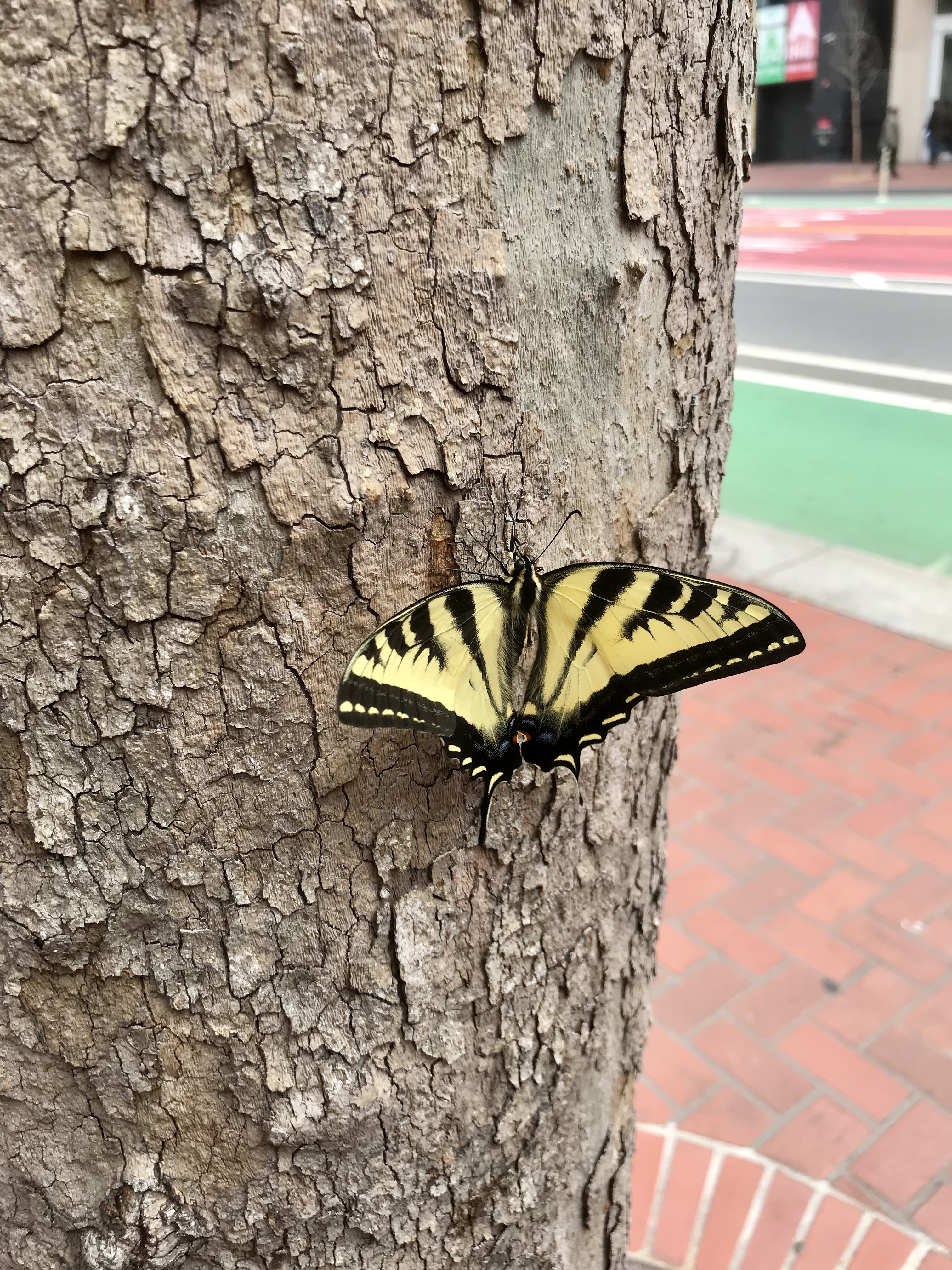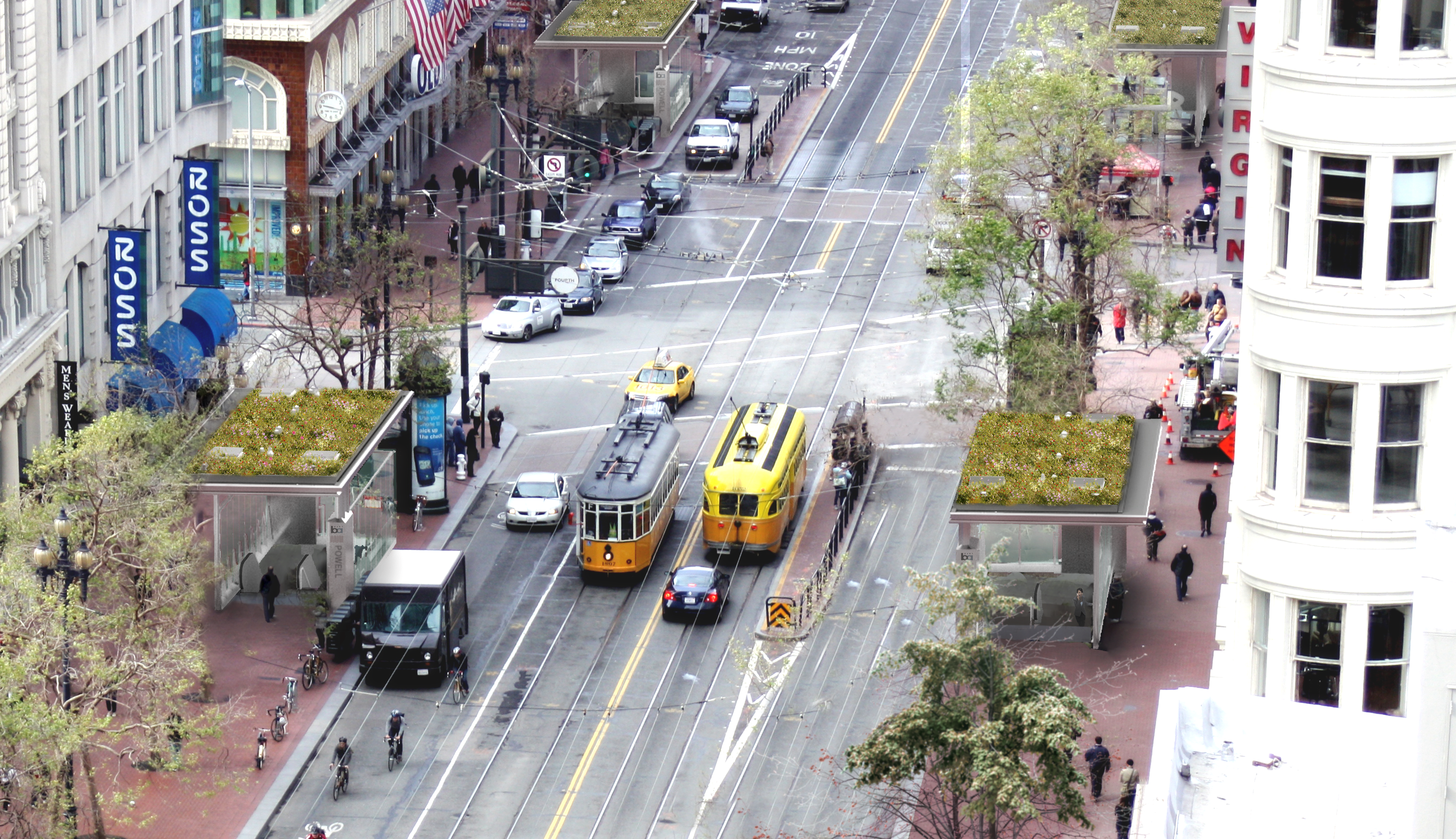Amidst the bustle of San Francisco’s Market Street, new BART/Muni Canopy Living Roof habitats are coming for western tiger swallowtail butterflies and other wildlife! The BART/Muni Canopy Living Roofs project will soon plant natives atop canopy structures over BART and MUNI entrances along San Francisco’s Market Street.
 Western tiger swallowtail butterflies (pictured) have been living a precarious existence among the bustle of Market Street since the 1980s when Market Street was first planted with London plane trees. From the butterfly’s perspective, Market Street, with its tall buildings lined with trees and nearby sun-filled plazas and parks, resembles its natural habitat: a river canyon with the butterfly’s larval food trees and nectar flowers in nearby meadows.
Western tiger swallowtail butterflies (pictured) have been living a precarious existence among the bustle of Market Street since the 1980s when Market Street was first planted with London plane trees. From the butterfly’s perspective, Market Street, with its tall buildings lined with trees and nearby sun-filled plazas and parks, resembles its natural habitat: a river canyon with the butterfly’s larval food trees and nectar flowers in nearby meadows.
But there is one big problem, nectar plants are scarce in this “canyon.” Thus, Nature in the City began the Tigers on Market Street project in 2018 to enhance habitat, focusing on adding nectar plants.
In 2021 BART invited Nature in the City to design living roof habitats for the station canopies. Once installed, the roofs will each provide 650 square feet of elevated habitat and become a major component of the project.
The project is looking for sponsors to fund the installation and maintenance of the living roofs.
Sponsorship Opportunities
Individuals, foundations, and corporations can invest in the BART Canopy Living Roof native habitat corridor at several sponsorship levels.
Contact [email protected] to learn more.
View the Nature in the City BART Living Roof project page.
Revitalizing Downtown San Francisco: A model for other cities
The pilot roofs, installed at Montgomery Station near the Palace Hotel and Powell Station near the Westfield Shopping Center, will be the first of their kind. Once the pilots are alive with habitat and wildlife, living roofs are planned for all 21 canopies from Embarcadero to Civic Center Stations.
In 2017, San Francisco became the first U.S. city to mandate solar and living roofs on most new construction. The BART Canopy Living Roofs project aligns with San Francisco's Climate Action Plan, specifically the Plan’s biodiversity and creative place-making goals. These elevated native habitat islands, rich with insect and bird life, will potentially transform Market Street into a model for other cities looking to create local climate solutions.
Project Design
The September 2022 community design workshop, led by Nature in the City, included experts from Switzerland, Stephan Brenneisen, Lieve Dierckx, and Lisa Lee Benjamin; staff from local community benefit organizations: Union Square Alliance, Yerba Buena Community Benefit District; and project leaders from BART, VIA – A Perkins Eastman Studio, RANA, BioStudio, and Resonate Agency.
The project’s native plant design is low-maintenance and drought-resistant, providing a habitat for western tiger swallowtails and other wildlife. The roofs are designed for ease of maintenance which will be done in partnership with BART, the City of San Francisco, and public and private stakeholders along Market Street. They will be beautiful on day one of installation!
Canopy Living Roof Goals
- Delivers habitat benefits
- Delivers community benefits
- Sustainable and water smart
- Compatible with canopy structure and BART operations
- Continuously maintained
Project Partners & Collaborators
- BART
- SFMTA
- San Francisco Public Works
- Nature in the City
- Shimmick
- Rana Cohabitat Co.
- Bio Studio
- VIA, a Perkins Eastman Studio
The Vision: With all 23 living roofs, imagine butterflies, birds, and other pollinators moving from habitat to habitat.
Rendering: VIA, a Perkins Eastman Studio
